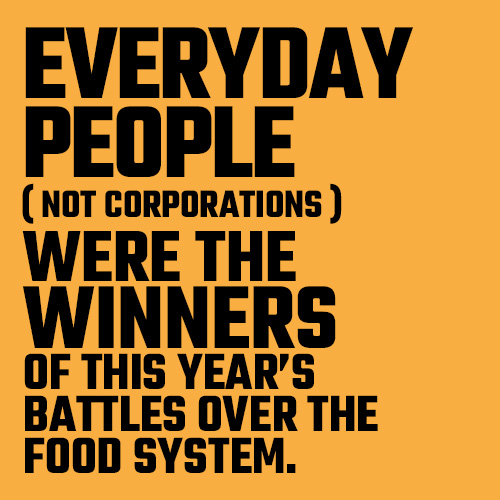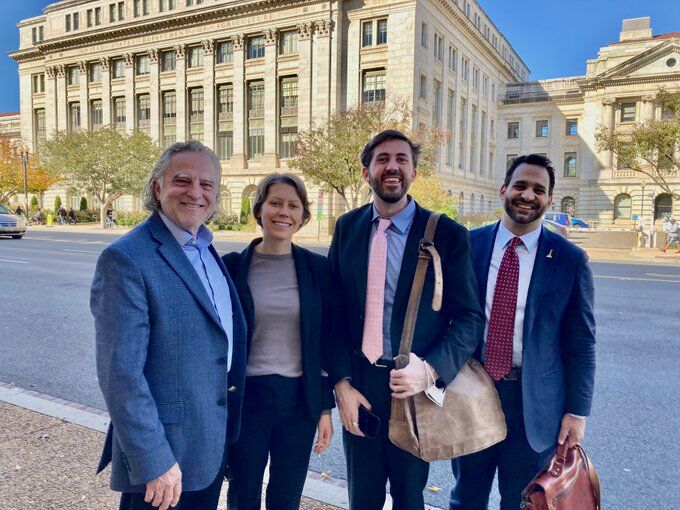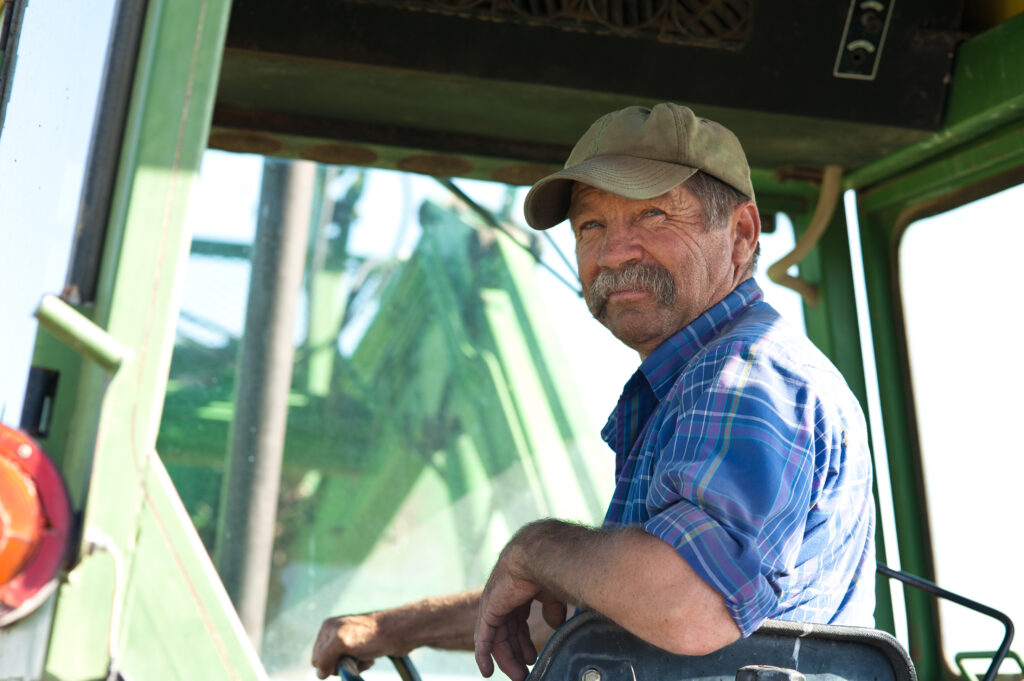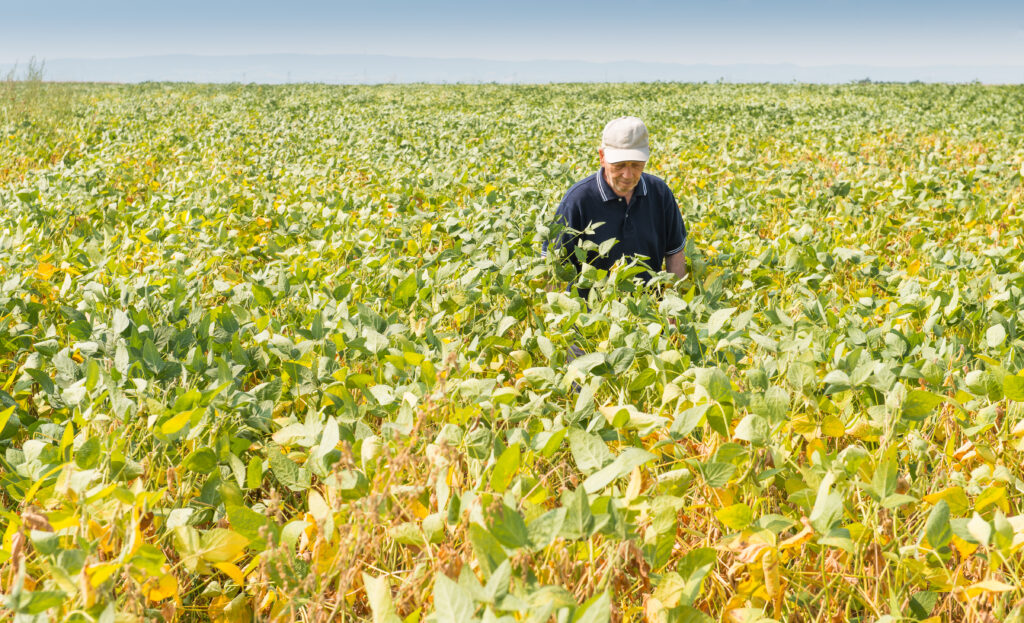2022 kicked off with a nationwide battle cry against monopoly power: On January 3, the voices of farmers and ranchers rang in the new year at President Joe Biden’s roundtable on competition in U.S. meat processing. On the heels of that event, Farm Action released research on food system concentration using the highly consolidated fertilizer industry as a case study, and our President Joe Maxwell testified before the U.S. House Judiciary Subcommittee on Antitrust, Commercial and Administrative Law to the on-the-ground impacts of monopoly power. Before the month was over, The Hill published a profile on Farm Action, calling us “an influential force” in the movement to create more competition in our food and farm system.
Now, as the year draws to a close, we’re taking a moment to tally each change to the consolidated status quo we achieved with our supporters and allies. Everyday people, not corporations, were the winners of these battles: The formation of an historic Equity Commission will address past and present wrongs, and stronger rules for the Packers and Stockyards Act will protect farmers and ranchers from abusive and anticompetitive corporations.
A more democratized food system is in the making, thanks to more than $1 billion secured to rebuild local and regional food production and distribution, and an investment in domestic fertilizer production will help farmers escape from under the thumb of global cartels.

Every part of the Biden-Harris administration has been activated in this fight: The Department of Justice (DOJ) effectively ended a deeply anticompetitive payment scheme for much of the contract poultry industry, and the Federal Trade Commission (FTC) restored its commitment to fully enforcing antitrust laws. The White House acknowledged the interconnected nature of our food policies and our public health crisis by including several of our recommendations in its National Strategy to improve public health outcomes.
We gained so much ground this year in our fight for a fair, inclusive, and competitive food system, and are pleased to be able to share each success with you.
Here’s a quick video recapping our year’s highlights, and read on for media highlights and a detailed play-by-play of work and wins in each of our issue areas. We look forward to seeing you in 2023!
Our Work and Wins by Campaign
Here’s a breakdown of what we did — and the results — in each of our core issue areas. Many of these campaigns are rapidly developing, so stay tuned in 2023 to see what comes next!
The lack of competition and growing monopoly power in our food and farm system was central to Farm Action’s founding. The White House thanked us for our Roadmap for the Biden Administration to Build Back Better, calling it the “playbook” to break up monopoly control over the food system. We were thrilled when President Biden issued the Executive Order on Promoting Competition in the American Economy in July of 2021. This included many of Farm Action’s recommendations and specifically dispatched the USDA, DOJ, and FTC to address monopoly power in the food and farm system.
What we did:
- In January, the FTC and DOJ opened a comment period on merger review guidelines, as directed by the executive order. In our public comments, we urged these agencies to dismantle the 1980s era “consumer welfare” antitrust framework — which has resulted in decades of unchecked consolidation and rampant market abuses — and establish new guidelines that prioritize a competitive marketplace.
- FTC and DOJ held a listening forum in March to hear about the state of competition from people in the agricultural system. Farm Action Vice President Angela Huffman testified to the on-the-ground effects of unbridled mergers. Farm Action Local Leaders Carrie Balkcom, Greg Gunthorp, and Chris Petersen also shared their perspectives.
- As June approached, we knew that the directives outlined in President Biden’s historic executive order were far from complete. To hold USDA, FTC, and DOJ accountable, we issued a joint report with Open Markets Institute, evaluating these three agencies’ progress on the directives contained within the executive order.
- We released the report at an event in Washington, D.C. called “Making the Grade? A Midterm Review of the Biden Administration’s Commitment to Food System Competition.” Right after the event, we headed over to the Hill with several Farm Action Local Leaders to follow up with decision-makers.
The results:
- In September 2022, President Biden announced a $15 million Agricultural Competition Challenge among state Attorneys General. The goal? A nationwide collaboration to enforce competition laws, such as the laws against price fixing.
- In another major win for competition, in November the FTC released a statement restoring its enforcement of laws banning anticompetitive behavior. The statement overturns past FTC policies that restricted its oversight, and commits the agency to exercising the full authority Congress granted it to challenge unfair tactics in the marketplace.
This was a big year for meatpacking. As the nation begins to understand how concentration in the meatpacking industry leads to rampant antitrust violations, our work to highlight the packers’ excessive profits in the face of rising consumer costs and the falling farmer shares of the retail dollar is making some traction. This shift has opened up new audiences and the national stage.
What we did:
- On March 24, Farm Action’s President Joe Maxwell dismantled myths from the North American Meat Institute (NAMI) before an online audience of thousands at a Federalist Society event called “Where’s the Beef? Inflation at the Grocery Store and Proposed Regulatory Responses.”
- We produced a research report in March demonstrating the importance of the Packers and Stockyards Act and antitrust law for American farmers raising livestock and poultry.
- Our Vice President Angela Huffman presented the findings from this report at the world’s largest antitrust conference, hosted in April by the American Bar Association.
- Back in June 2021, the USDA announced it would begin work on new rules to strengthen the Packers and Stockyards Act — which we called for in our recommendations for the incoming Biden administration. In August 2022, we submitted public comments on the first rule, which unequivocally urged the USDA to ban the abusive tournament system, a corrupt and abusive payment scheme in the contract poultry industry.
- All this work has caught the attention of decision-makers: We have been invited to meetings at the DOJ and USDA to brief them on our concerns about this industry.
The results:
- The DOJ effectively banned the tournament system for a large number of chicken farmers in a proposed consent decree with Cargill, Sanderson Farms, Wayne Farms, and others. Our comment on this legal action praised DOJ for ending this “unjust payment system that Sanderson and Wayne have used to deprive poultry growers of their independence and extract untold wealth from rural communities.”
- In January, the White House announced plans to give an unprecedented boost to the independent meat processing industry — which has for decades been dominated by global monopolies. To build resilience and competition back into U.S. meat production, the USDA will help support:
- Community-based diversified processing plants ($375 million)
- Inspection costs for small plants ($100 million)
- Training for the next generation of highly-skilled butchers ($100 million)
- Farm workforce training in underserved communities ($14 million)
When Farm Action’s Local Leaders told us about a massive spike in fertilizer prices — which happened to coincide with increased income farmers were earning for commodity crops — we leapt into action, elevating the issue into the national conversation.
What we did:
- In late 2021, we wrote a letter to the DOJ, calling for an investigation into the highly consolidated fertilizer sector on the suspicion of anticompetitive practices.
- In January, we published a report on the fertilizer industry, demonstrating how fertilizer corporations use the false pretense of supply chain disruptions to gouge farmers and tie their prices to commodity prices — effectively stealing farmers’ profits.
- Farm Action’s President Joe Maxwell then testified before the U.S. House Judiciary Subcommittee on Antitrust, Commercial and Administrative Law on the state of food and farm system concentration, and used this stage to highlight the rampant price gouging in the fertilizer industry.
- Then in June, 23 organizations signed onto our public comments advocating for a more competitive and democratized fertilizer industry. We called for the USDA to direct its investment away from consolidated cartels.
The results:
- USDA is investing $500 million into our domestic fertilizer production to increase resilience in the face of global catastrophes like war and extreme weather events. Farm Action will continue to work with USDA to ensure this investment doesn’t wind up in the pockets of monopoly corporations but rather bolsters independent fertilizer firms.
Shaped by the stories from our network of farmers and rural Americans, Farm Action’s Fair Farm Bill Campaign kicked into high gear in 2022.
- We rang in the year with a series of testimonial videos from our Local Leaders, who shared how policies in the farm bill affect their businesses, communities, and daily lives.
- In May, we published a first-of-its-kind Fair Farm Bill Policy Handbook: a straightforward guide of concise, concrete, and actionable policy recommendations within each of our four categories of change for the farm bill. If Congress acted on these recommendations, they could transform our food and farm system and achieve our vision of a fair, inclusive, and competitive food system.
- We also created a handy Fair Farm Bill Primer to help people get up to speed on all the farm bill programs, agencies, and acronyms.
- To support anyone advancing the goals of a Fair Farm Bill in their state, we also published a free, downloadable, unbranded advocacy toolkit packed with resources for a successful campaign.
- We took our Fair Farm Bill campaign on the road to several conferences in 2022. Most recently, our Policy Advocate Sarah Carden presented our goals and objectives at the Regenerate conference, hosted by the American Grassfed Association.
2023 will see us transition into the most aggressive outreach and advocacy portion of this campaign yet. Stay tuned!
The first pillar of our Fair Farm Bill Campaign spotlights the need for Food, Not Feed. Our government, using taxpayer dollars, is propping up an abusive, industrial food and agriculture system that is making us sick, driving farmers off the land, caging animals, and destroying our water, soil, and air. This system prioritizes feeding corporate-controlled poultry and livestock over putting food on our neighbors’ tables. In fact, the United States is facing a national security crisis as we’re now importing more food than we export.
What we did:
- In our Fair Farm BIll Policy Handbook, we recommended increased funding for the USDA’s GusNip Produce Prescription Program, which has been proven to increase fresh fruit and vegetable consumption and reduce food insecurity.
- We called on the USDA to increase funding to assist farmers transitioning to organic and regenerative food production models.
- We also urged the agency to expand crop insurance options to support more diversified, regenerative, nonconventional operations that produce food for people.
The results:
- In June, the GusNIP Produce Prescription Program received an infusion of support through the Framework for Shoring up the Food Supply Chain; the Framework was itself rooted in the Executive Order on Competition, which contained Farm Action recommendations ($40 million).
- In August, USDA announced it would support farmers transitioning their operations to organic with the Organic Transition Initiative ($300 million).
- That same month, USDA announced it would update its Micro Farm and Whole-Farm Revenue Protection crop insurance programs to make them more accessible to farmers. This improvement reflected our recommendations and will improve overall insurance access for Specialty Crop, Organic, Direct Market and other producers.
Farm Action will be hosting a Food Not Feed Summit in February 2023 with the support of more than a dozen other organizations. We’re taking the enthusiastic reception for the ideals behind this event as a sign that our call for “Food, Not Feed” resonates with a broad swath of people.
Rooted in the fact that everyone would benefit from a more fair and inclusive society, “Justice for All” is the second pillar of our Fair Farm Bill Campaign. Guided by groups like Rural Coalition, of which Farm Action is a member, this work is how we participate in the wider movement for food system equity.
What we did:
- Farm Action’s Roadmap for the Biden Administration to Build Back Better urged the administration to increase tribal sovereignty and self-determination so that Indigenous people can access and support the production of fresh and traditional local foods.
- We pointed to the need for an Equity Commission in both our recommendations to the incoming Biden-Harris administration and our Toolkit for Congress to Tackle the Food Monopoly Crisis. This commission would monitor USDA programs to understand barriers based on race, gender, ethnicity, gender identity, and more.
- Our Fair Farm Bill Policy Handbook called for debt repayment of USDA loans from small farms to address discrepancies in agriculture institutions’ lending habits, as well as credit practices that disproportionately affect marginalized communities.
The results:
- We didn’t have to wade too far into 2022 before the administration released its USDA Equity Action Plan, which announced the creation of an Equity Commission. This group of stakeholders has been tasked with a thorough review of USDA policies and programs and providing recommended actions to improve equity.
- The August passage of the Inflation Reduction Act swept in a huge investment for the American food system and everyone it touches.
- Farmers struggling with USDA-backed loans and farmers who have faced discrimination in accessing such loans became eligible for long-awaited relief and assistance. This was a win for independent food production and rural communities, which depend on farms to be economic engines.
- Technical assistance, outreach, and mediation for marginalized and underserved producers received a major infusion of support ($125 million).
- Land loss assistance, such as heirs’ property and fractionated lands, will become more readily available ($250 million).
- To help ensure there will be a next generation of food and farm system leaders, historically Black, tribal, and Hispanic colleges received support for agricultural education ($250 million).
- Historically under-funded conservation programs that reward farmers for earth-friendly practices (EQIP, RCPP, CSP, and ACEP) received a boost in funding this year. Half of EQIP’s budget was formerly reserved for livestock, giving industrial agriculture corporations unfair access to conservation funding through things like methane digesters. As part of this funding boost, EQIP’s “set-aside” rule was discarded, freeing up funding to support practices that actually benefit the soil, water, and air.
- In today’s world, rural Americans need to be connected to the internet to succeed. This legislation included a national broadband plan utilizing rural electric cooperatives, as recommended in our transition plan for the incoming Biden administration.
- USDA announced steps to correct its history of discrimination in August, starting with new opportunities for projects that improve access to land, capital, and markets. The agency also announced support for minority-serving institutions that create career development opportunities for the next generation of agriculture leaders ($550 million).
- In November, USDA announced it would support a number of measures to “[empower] tribal self-determination and [bring] Indigenous perspectives into agriculture, food, and nutrition.” This support will benefit initiatives like seed-saving hubs, traditional recipes and cooking videos, and educational materials on foraging wild and indigenous plants.
Rural America was once home to interconnected and locally based food production systems: powerful economic engines that created jobs, sustained their communities, and fed the nation. Since our founding and at every possible opportunity since, Farm Action has called for policies that equitably rebuild these local and regional food systems, which have been decimated in an era of rampant corporate consolidation and wealth extraction.
In 2022, we saw great successes in our work to Build Local, Eat Local — the third pillar of our Fair Farm Bill Campaign.
What we did:
In our seminal Roadmap for the Biden Administration to Build Back Better, our Toolkit for Congress to Tackle the Food Monopoly Crisis, and our Fair Farm Bill Policy Handbook, we detailed policies that will build resilience into our food system — allowing farmers, ranchers, and workers to feed their neighbors even in times of global catastrophe — and reinvest in rural America.
The results:
In 2022, the Biden administration proved they were listening — in a big way. Here are some of the ways the USDA has announced it will bolster independent and locally based food production, which will shorten and strengthen our supply chains and usher in the return of economic viability for the families who live and work in rural America.
- More financing options for independently owned food processing, distribution and aggregation infrastructure, and other projects in the middle of the supply chain ($100 million for the Food Supply Chain Loan Guarantee Program)
- Better nutrition and access to locally grown fruit and vegetables for seniors through the Senior Farmers Market Nutrition Program ($50 million)
- Better nutrition for schoolchildren and increased support for local and underserved producers through purchasing assistance with local foods for schools ($200 million to Local Foods for Schools Cooperative Agreement Program, $400 million to Local Foods Purchase Assistance Cooperative Agreement Program)
- Help with on-farm food safety expenses for specialty crop growers ($200 million)
- Help for agriculture in urban areas ($75 million)
The fourth pillar of our Fair Farm Bill Campaign holds that recipients of subsidized insurance programs and disaster payments should be required to commit to conservation and regenerative practices.
What we did:
In our Fair Farm Bill Policy Handbook, released and circulated this year, we made the following recommendations:
- Permanently fund the Pandemic Cover Crop Program through the farm bill.
- Increase baseline funding for conservation programs.
- Authorize and fund the USDA Regional Food Business Centers Program to support farmers and small food businesses with technical assistance and business development.
The results:
- U.S. Rep. Sean Casten (D-IL) introduced the COVER Act in July, which legislates the Pandemic Cover Crop Program. With or without its inclusion in the farm bill, this legislation has a chance of passing, codifying the program permanently.
- In August, USDA announced expanded investment for locally led conservation efforts.
- In September, USDA answered our call for Regional Food Business Centers. The centers will “provide essential local and regional food systems coordination, technical assistance, and capacity building services.”
Food labels are a critical component of our food economy, affecting farmers’ ability to earn fair prices for their products and supporting the growth of local and regional food systems. Rampant fraudulent labeling and greenwashing have been a core Farm Action issue, and in 2022 we held both corporations and government officials accountable for the consequences of unethical labeling practices.
- Farm Action rallied the troops to engage with USDA’s “Product of USA” Labeling comment period — and engage they did! More than 1,000 comments were submitted by the public, illustrating all the ways current labeling practices hurt American farmers and deceive consumers. In December, Secretary Vilsack acknowledged the deceptive practices described by so many commenters — for example, importing meat only to repackage and relabel it with “Product of USA” — and the need to strengthen USDA’s policies.
- After two separate studies found traces of antibiotic residue in meat sold by Whole Foods under a USDA-approved no-antibiotics labeling program, Farm Action teamed up in April with American Grassfed Association to send USDA’s Food Safety Inspection Service (FSIS) a letter requesting an immediate recall and investigation into the reported presence of antibiotics.
- We followed up our letter with several meetings with FSIS officials, in which we continued to push for action.
- Then in October, we produced a blog with Farm Action Local Leader Mike Callicrate and the organization Farm Forward, in which we detailed USDA’s fraudulent antibiotic-free label and called for action and accountability.
Corporate farm equipment manufacturers use their monopoly control of the market to rob farmers of their consumer rights by restricting access to basic diagnostic tools and limiting farm equipment repair to authorized dealers. This has driven independent repair shops out of business and pushed repair costs, wait times, and equipment transport distances up to untenable levels for farmers.
For too long, a handful of global corporations have stifled the spirit of self-sufficiency and innovation in rural America. In 2022, Farm Action worked to give farmers and small businesses a fighting chance.
What we did:
- We helped Sen. Jon Tester (D-MT) develop his Agricultural Right to Repair bill, which was introduced in February.
- In March, we worked with several other farm organizations to file an FTC complaint against John Deere, in which we urged the FTC to investigate the corporation’s abusive repair restrictions.
The results:
- One month later, we were thrilled to learn that the FTC had taken our advice and launched an investigation into Deere’s repair restrictions.
- Farm Action Local Leader Willie Cade has been leading the Right to Repair charge in his own work. Willie discovered that Deere’s repair restrictions may be in violation of the Clear Air Act, which would empower the EPA to take action against Deere.
In an era of unprecedented corporate consolidation, monopolies have made food production harmful to farmers, workers, and entire communities by relying on extractive, mechanized, and industrialized practices. The United States’ backwards food policies — which prioritize the production of cheap animal feed and processed foods over nutrient-dense food — are driving poor health outcomes. As a result, the United States is facing a public health crisis of epidemic proportions.
In 2022, we focused on how we could create a healthier food system. Our work highlighted the links between U.S. food policies, the availability of certain foods, and the rise of dietary-related diseases.
What we did:
- The White House Conference on Hunger, Nutrition, and Health provided a national platform to highlight the connection between the United States’ growing health crisis and our backwards farm subsidies. In July, we submitted a set of policy recommendations to the White House, which identified key barriers to health written into the U.S. food system — and how to dismantle those barriers.
- Leading up to the White House Conference, Farm Action’s Vice President Angela Huffman was invited to participate in one of the few in-person Convening sessions, which informed the White House’s priorities.
The results:
- When the White House released its National Strategy to improve public health outcomes, we were delighted to find it contained many of our recommendations.
- Another huge achievement for a healthy food system came in June, when the GusNIP Produce Prescription Program received an infusion of support ($40 million). We recommended increased funding for this important program in our Fair Farm Bill Policy Handbook because it is proven to increase fresh fruit and vegetable consumption, improve health, and reduce food insecurity.
Media Highlights
Top Media Coverage
Our work repeatedly captured the attention of reporters across the nation in 2022. Out of more than 450 media stories, here are the top five:
Top Videos
This year, we brought our work to life with more videos than ever. Here are the five videos our supporters liked best.
Top Blogs
We researched and published 22 blogs this year. Our flagship Root of the Issue blogs and our quick-take News to Chew on blogs reached thousands of readers, providing them with the information they need to challenge monopoly power in their own communities.
Support Our Work
Written and designed by Dee Laninga; edited by Sarah Carden, Cathy Cowan Becker, Angela Huffman, and Joe Maxwell.




